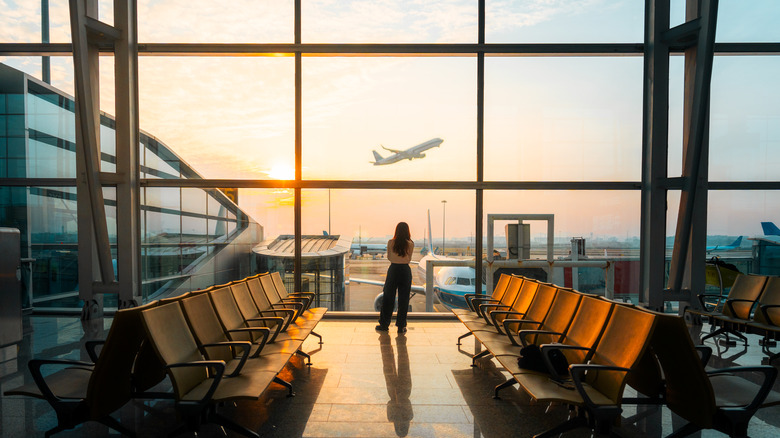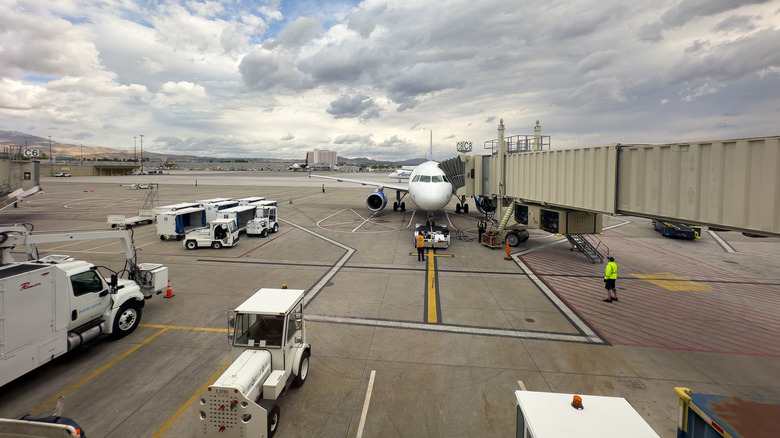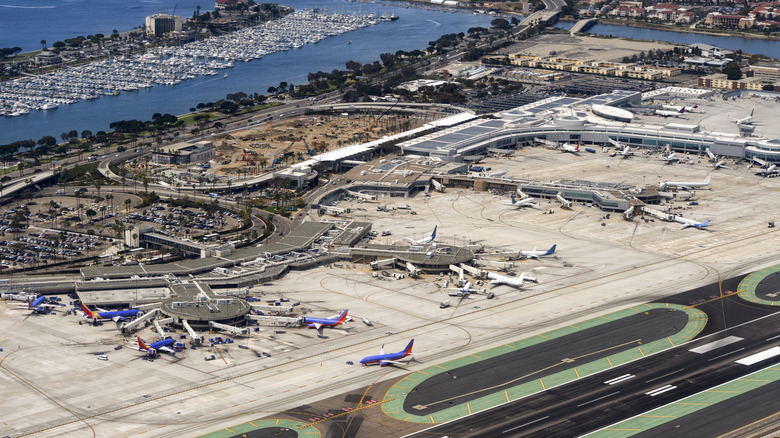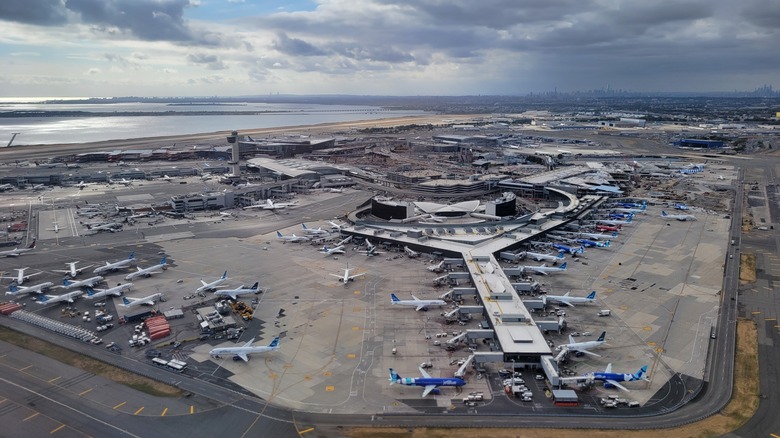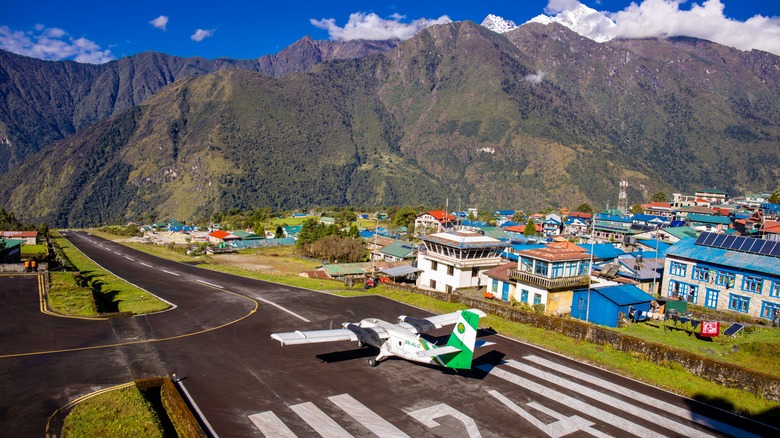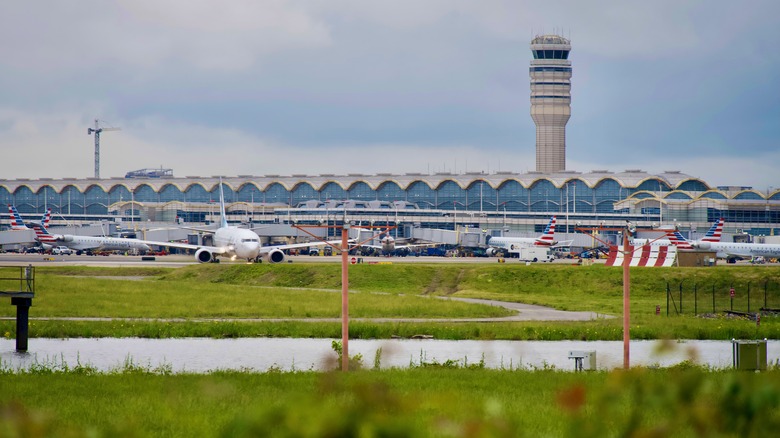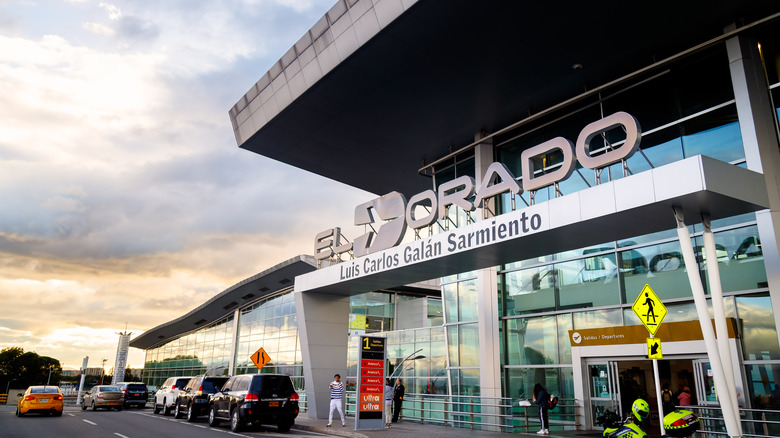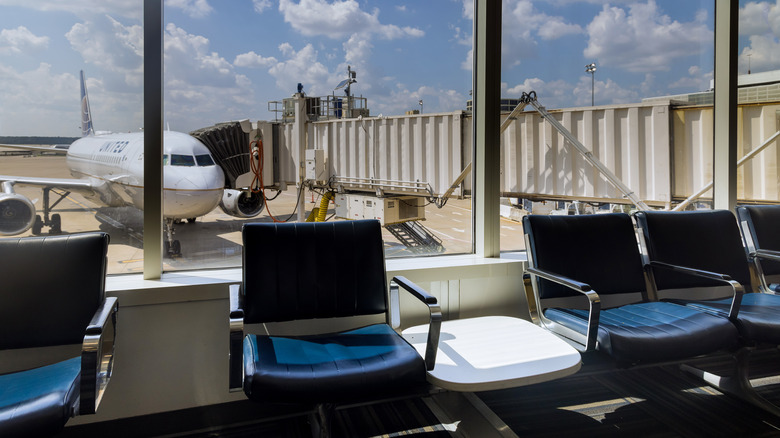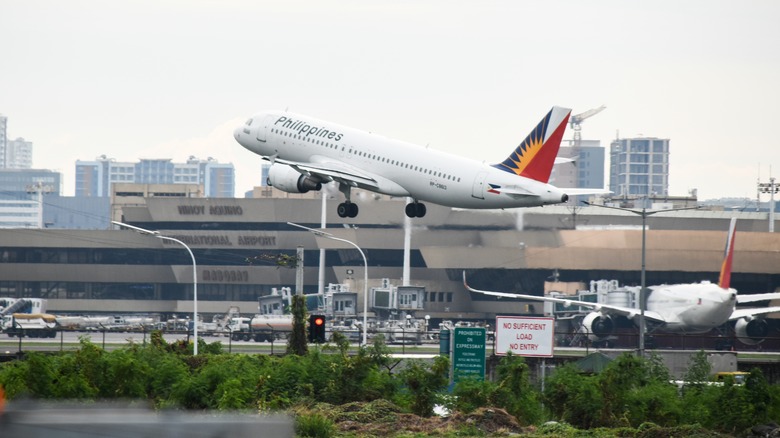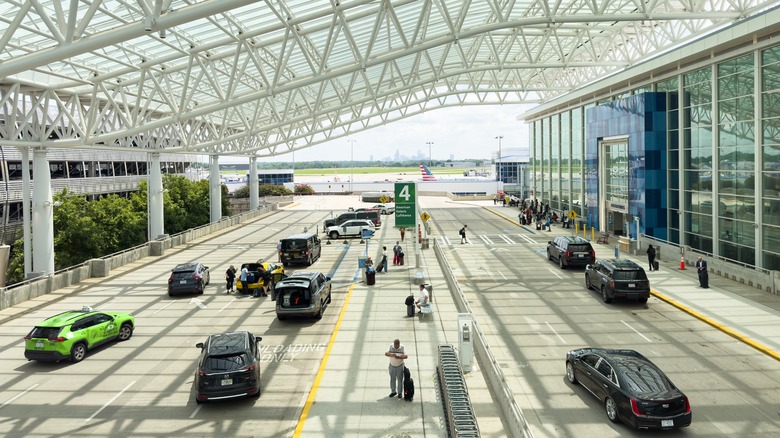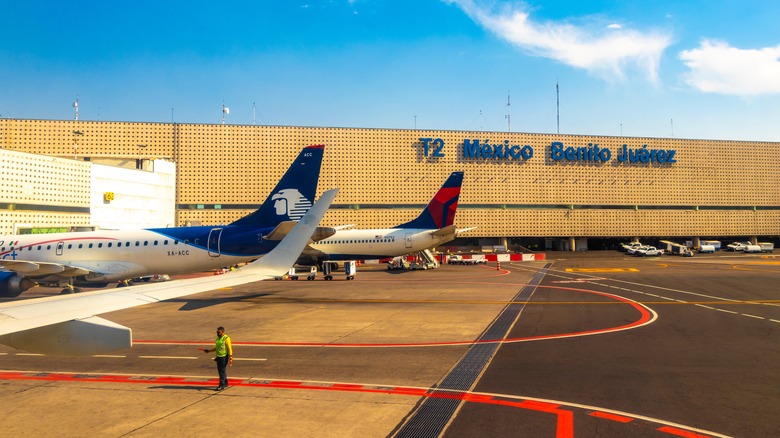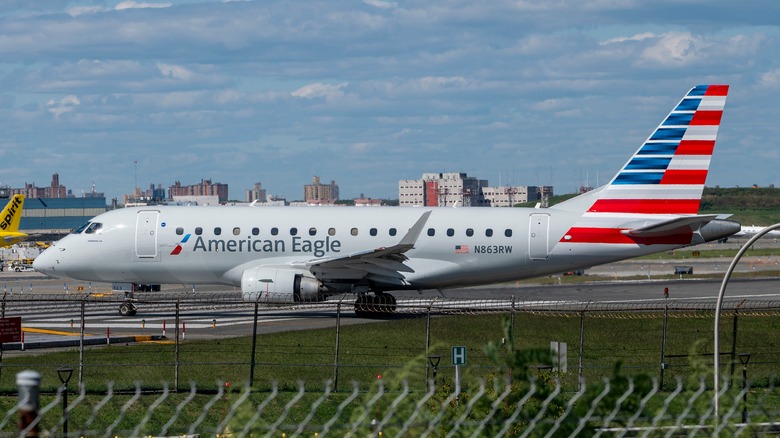The Airports That Pilots Secretly Despise Flying Into
Whether it's long lines or lost luggage, a rough airport experience has the potential to ruin any vacation. After you make it through security and get to your gate on time, the flight is the final obstacle before you're able to let out a sign of relief. Sure, there are plenty of travel tips from experts like Rick Steves to help you navigate difficult experiences in a fairly pain-free way, but for pilots, travel difficulties aren't so easy to fix. Their biggest obstacles? The airports.
Pilots aren't always making the exact same routes every time they're in an aircraft, but after a while they become familiar with how each airport operates. In the same way an average commuter might be familiar with stations along their train route, pilots become familiar with the idiosyncrasies of different airports. Considering their expertise and experience, their perspective on airport efficiency is a valuable one to understand how well some of the busiest airports are actually operating.
We scoured the internet in search of pilots' takes on their preferred and not-so-preferred airports. Using responses from the r/Flying subreddit, we found some very strongly-worded opinions from our guides of the skies. While there were plenty of praises for well-run destinations, there were even more critiques for airports around the world that pilots deem "the worst."
In addition to this Reddit thread, we've searched for responses on Quora and other forums from seasoned pilots on this subject. We did our best to breakdown some of the technical language to give passengers a peak behind the scenes of typical flight interruptions. Whether its remote runways in the Himalayas or an airport surrounded by no-fly zones, here are the airports pilots secretly despite flying into.
Reno-Tahoe International Airport
Snugly situated in a valley surrounded by mountains, the Reno-Tahoe International Airport (RNO) is not a pilot favorite when it comes to turbulence and wind. According to Turbli, Reno is ranked the eighth most turbulent airport in the United States in 2024. The specific route between Reno and Las Vegas also ranks as the ninth most turbulent. The site uses data from the National Oceanic and Atmospheric Administration (NOAA) to calculate the routes' Eddy Dissipation Rates (EDR), which is the standard metric for turbulence, according to Skybrary. While you may be facing motion sickness, pilots aren't having the best time navigating choppy air either.
One user perfectly summed up the turbulence issue saying on the Reddit thread, saying, "Tons of mountains around the airport makes for complicated single engine procedures. Awful weather, especially with turbulence and wind shear." Depending on the direction, aircrafts could be facing different kinds of winds relative to surrounding mountains — traveling with the wind toward mountains is aided by rising currents. By contrast, airplanes traveling toward leeward, or the side of the mountain sheltered by the wind, are up against descending currents and turbulence.
Facing the Sierra Nevada mountain range that borders Nevada and California, the changes in rising currents and descending winds could explain the high turbulence in flight around Reno. If you're planning on visiting Reno, the "Biggest Little City" in the world, be prepared for a few bumps on your flight into town.
San Diego International Airport
The mountains of Southern California can also produce some difficult waves of wind for pilots to navigate. However, this isn't their biggest grievance at San Diego International Airport (SAN), the third busiest airport in California. A parking garage, known as Laurel Airport Parking, nearly obstructs the arrival flight path for planes landing in San Diego. Retired pilot Reg Prewitt said on Quora, "It should never have been allowed to be built."
The issues with the six-story parking garage go back decades. In 1988, the Los Angeles Times reported that the Air Line Pilots Association warned the garage was an "accident waiting to happen." Despite that warning, the Federal Aviation Administration (FAA) only designated the parking garage as an "obstruction" and not to rely only on the aircraft's landing system, according to the story.
Since then, the Laurel Airport Parking Lot has stood strong in San Diego. While the parking lot has become a hot-spot for avid plane spotters, pilots are still not so enthused. "Pilots are paid to do our job, not be concerned with what is beyond our power," Prewitt added. With new terrain and unpredictable weather, a smooth descent can be tricky for some pilots — adding a parking lot to avoid only complicates things for aircraft operators of all levels. It may be for more obscure reasons that regular passengers may never notice, but San Diego International Airport earned its spot as a least favorite airport for pilots.
John F. Kennedy International Airport
Any kind of weather changes can be a headache for pilots and travelers alike. However, around New York City, the country's largest metropolitan area, it can completely delay travel time by hours at John F. Kennedy International Airport (JFK). One Redditor's comment sums up how quickly delays can emerge around the busy airspace: "The 1-2-3 rule in NY. 1 drop of rain, 2 clouds, 3 hour [Expected Departure Clearance Time]."
The drawn-out weather delays in JFK aren't because of protocols at the airport, but are more-so related to the aviation giant's proximity to other airports. "[New York] airspace is so congested and tight that any [weather] deviation, even along the arrival and departure corridors and not specifically in the metro area, can f*** up the flow bad," another Reddit comment read. Although it may seem minimal at times, one minor weather delay can have a domino effect, pushing delays further.
The Redditor's concerns are reflected in the numbers, too. According to the Weather Channel, JFK ranked the seventh most weather-delayed airport with a percentage of time delayed due to weather reaching almost 43% from 2012 to 2024 (excluding data from 2020). Being one of the busiest airports in the country comes with its caveats — even if there's no storms in the immediate forecast, brace for possible weather-related delays at JFK.
Tenzing Hillary Airport
Just 85 miles northeast of Kathmandu, Nepal is this small airport that's also about 40 miles from the basecamp of Mount Everest, the highest mountain peak in the world. Aspiring climbers frequent the Tenzing-Hillary Airport (LUA), aka Lukla Airport, which has gained the nickname "world's most dangerous airport." While climbing the Himalayas is a dangerous trek, making it through this airport is another adrenaline-pumping activity.
The primary danger of Lukla's airport is the notoriously short runway, which measures only 1,729 feet. In comparison, most commercial airline runways are between 8,000 and 13,000 feet. At the end of the runway is a steep drop into a valley. Despite its unorthodox conditions, roughly 50 flights arrive and depart from there daily during peak seasons.
Other dangers in Lukla are related to weather and geography. A location in the Himalayas at a high elevation, which creates a host of difficulties compared to airports at sea-level. Different air density, temperatures, and reduced air resistance have unique impacts on aircraft engines. The surrounding mountain range and unpredictable weather can produce strong winds, fog, and dense storm clouds. Reduced visibility combined with a small target runway make this small airport a challenge.
Ronald Reagan Washington National Airport
Descent into Washington D.C. may give some great views of the historic buildings in the nation's capital, but this comes with a major caveat. The area around Ronald Reagan Washington National Airport (DCA) is filled with no-fly zones that surround places like the White House, the National Mall, and the Vice President's residence. There are pretty high stakes for violating these no-fly zones too. According to the Federal Aviation Administration (FAA), pilots could have their certificate revoked, face monetary penalties, and/or be charged with criminal actions if deemed warranted.
Another common complaint was regarding delays in requests for a "push," referring to the pushback procedure where an external vehicle pushes the aircraft from the gate to prepare for the runway. This can be a cause of issues that leave passengers scratching their heads about what delays they may be facing once the plane is boarded. One commenter on Reddit said, "Trying to get a word in to call for push is a nightmare sometimes."
DCA's behind-the-scenes traffic problems may not be so apparent for the usual passenger, but they are often a point of irritation for pilots. Next time you're groaning on the tarmac because of undisclosed delays, remember that pilots are working their hardest to navigate some of the most frustrating airports in the world.
El Dorado International Airport
Bogotá, Colombia's capital, is known for its high elevation and mountainous terrain that give unbeatable views while visiting. The city is home to nearly 8 million people and is a mecca of food, culture, and unreal views. So, it makes sense why so many tourists make their way to Bogotá with over 1.3 million foreigners arriving in 2023. However, what many of these passengers may not consider is that the airport, El Dorado International Airport (BOG), is an aviation nightmare.
Complaints on Reddit included that the airport is "mountainous, high altitude, [Air Traffic Control] is atrocious" and "I've heard it said that the reason it's called El Dorado is because, after dark, you feel like you've struck gold just by finding it."
According to Skybrary, mountainous terrain can have a substantial impact on wind patterns. Specific types of wind called "mountain waves" are strong gusts of wind that blow perpendicular to mountain ranges. Additionally, high altitudes have adverse effects on aircraft engines, and El Dorado sits at nearly 8,400 feet above sea level. Surrounded by the Andes mountain range, it makes sense how pilots could be facing intense mountain waves during takeoff and landing. Combining intense mountain terrain with sometimes unhelpful air traffic control can make things difficult for pilots simply trying to touchdown in Bogotá.
George Bush Intercontinental Airport
For George Bush Intercontinental Airport (IAH), Houston's international hub, pilots' responses seemed more frustrated with aviation protocol than actual airport structure. One Redditor responded to the inquiry, saying, "I don't think I've ever landed in IAH WITHOUT a runway change. Plus their stupid taxi routes!" This frustrated Redditor is referring to IAH's reputation as having one of the longest taxi-in and taxi-out times in the country.
According to Simply Flying, George Bush Airport made the top ten of longest taxi times in the U.S. with an average taxi time of 18.9 minutes. While it wasn't number one on the list, the combination of Houston's extended taxi times and ongoing construction adds to some of the frustration from pilots. For periods of time, Houston has ranked within the top 10 highest taxi-in and taxi-out times in the country. With anticipated changes to the airport, passengers and pilots alike are hoping for greater efficiency on the tarmac.
The airport is currently undergoing a $2.5 billion renovation with sporadic terminal closures and reroutes for passengers. The renovation, expected to complete in 2026, will update baggage handling services and add 22 new gates, according to Houston Public Media. The addition of new gates is sure to redesign the ongoing runway layout that has been a pain point for many aviation professionals and only completion will tell if those issues can be resolved.
Ninoy Aquino International Airport
To understand the specific aviation grievances with Ninoy Aquino International Airport (MNL), Manila's international airport, there are a few codes to decipher. One particular Redditor left a specific list of issues with this airport, saying, "'Interesting' ATC/vectoring ... Multiple STARS, always changed mid-arrival, high terrain, quickly changing tropical/stormy weather, badly congested radios, confusing ground instructions."
No, these aren't Star Trek captain codes. Vectoring is how air traffic control guides the aircraft using directions via radio. "Multiple STARS" refers to standard terminal arrival routes. Having multiple, changing standards kind of defeats the purpose of creating a standard and can lead to confusion for incoming pilots who are not familiar with the airport layout. Not only is the airport facing high terrain upon descent, like Mount Batulao or the Masangi Georeserve, but is also directly flanked by two bays. The Manila Bay and Laguna de Bay expose the city to increased winds from monsoons or storms, making the city (and incoming airplanes) susceptible to unpredictable weather and wind patterns.
Aside from geological complications and technical obstacles, pilots also reported more general communication issues with Manila personnel. Although the Philippines is home to some of Asia's best beaches, limestone cliffs, and turquoise waters, this laundry list of complications explains why pilots may not be so enthused to fly into Manila.
Charlotte Douglas International Airport
Amongst the more unexpected entries for pilots' least favorite destinations is Charlotte Douglas International Airport (CLT) in Charlotte, a metropolis filled with historic homes, secret gardens, and shopping boutiques. "Can't believe I had to scroll so far to find CLT slander," one Reddit comment read. "Worst use of pavement and airspace I've ever seen." Many other responses echoed this sentiment.
A thread on Flyertalk addressed Charlotte Douglas International by name, asking, "Why do people dislike CLT so much?" The response included overcrowded walkways and short connection times considering airport size. As of this year, American Airlines implemented a technology in Charlotte to optimize holding flights for passengers to be able to make their connecting flights, according to Forbes.
The Charlotte hub ranked the third busiest airport for connecting flights in 2025 with more than 75% of passengers in the airport passing through on connecting flights. Other passenger comments included grievances with TSA closures, ranking it "a top 10 worst airport." One pilot responded to the comment, reassuring passengers everywhere that "if you're a [passenger] and hate a certain airport, there's a good chance [pilots] also hate it."
Mexico City International Airport Benito Juárez
Mexico City's combination of urbanism and gastronomy may combination perfect for a weekend trip but, according to pilots, Mexico City International Airport Benito Juárez (MEX) is a perfect storm for aviation difficulties. From one pilot's perspective, the air traffic controllers in Mexico City may need to refresh their vectoring procedures. "They'll literally vector you off the arrival and into the side of a mountain in Mexico City," they commented on Reddit.
Not only did another commenter mention the "last minute runway assignments," but others also mentioned it's very close to a "volcano that is in a constant state of eruption." What pilot wouldn't want to encounter Popocatépetl, the active volcano 43 miles from Mexico City that has been constantly spewing gas and ash for the past 20 years? Flights have even been diverted and canceled from cities in Mexico as a result of increased activity from Popocatépetl.
On top of the active volcano, Mexico City's geography has another factor common among pilots' least favorite airports: high altitude. At an elevation of over 7,000 feet, Mexico City's airport qualifies as hot and high conditions, which refers to "a combination of aerodrome altitude and temperature which have a detrimental effect on aircraft performance," according to Skybrary.
LaGuardia Airport
Although a favorite for many fans of the Big Apple, LaGuardia Airport (LGA) can be quite unenjoyable for pilots. After a redevelopment project that cost $8 million and nearly 10 years to complete, one might assume LaGuardia's aviation problems were a thing of the past. However, pilots continue to experience their own issues on the tarmac.
LaGuardia is infamous for its short landing strips overhanging a bay, making it more susceptible to weather changes. Weather changes around New York can bring extensive delays for any planes trying to arrive or depart, and with a number of other international airports in the area, the crowded airspace is another challenge for pilots. Although there may not be weather diversions visible from the tarmac, storms on the paths for yet-to-leave flights can cause delays or cancellations. When this happens, a domino effect of gate reassignments or pushback holds can be expected. For pilots, however, the issues don't stop once the plane has landed.
"Once the wheels are on the ground that is the most fkd up place to possibly operate an airplane," said one angry Redditor. LaGuardia's peak times fall in the early morning and early evening, so navigating the two runways can be a nightmare for pilots.
